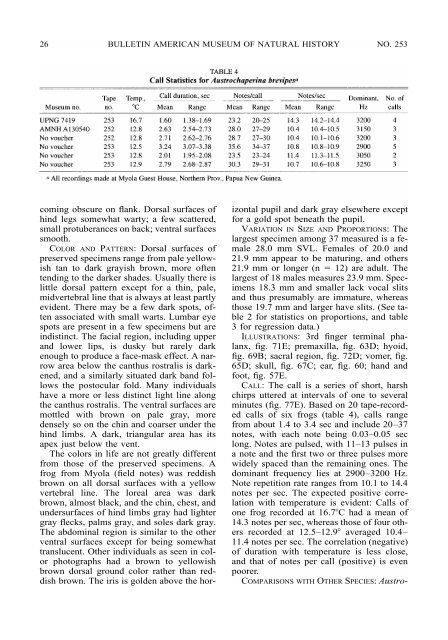SPHENOPHRYNE - American Museum of Natural History
SPHENOPHRYNE - American Museum of Natural History
SPHENOPHRYNE - American Museum of Natural History
You also want an ePaper? Increase the reach of your titles
YUMPU automatically turns print PDFs into web optimized ePapers that Google loves.
26 BULLETIN AMERICAN MUSEUM OF NATURAL HISTORY NO. 253<br />
coming obscure on flank. Dorsal surfaces <strong>of</strong><br />
hind legs somewhat warty; a few scattered,<br />
small protuberances on back; ventral surfaces<br />
smooth.<br />
COLOR AND PATTERN: Dorsal surfaces <strong>of</strong><br />
preserved specimens range from pale yellowish<br />
tan to dark grayish brown, more <strong>of</strong>ten<br />
tending to the darker shades. Usually there is<br />
little dorsal pattern except for a thin, pale,<br />
midvertebral line that is always at least partly<br />
evident. There may be a few dark spots, <strong>of</strong>ten<br />
associated with small warts. Lumbar eye<br />
spots are present in a few specimens but are<br />
indistinct. The facial region, including upper<br />
and lower lips, is dusky but rarely dark<br />
enough to produce a face-mask effect. A narrow<br />
area below the canthus rostralis is darkened,<br />
and a similarly situated dark band follows<br />
the postocular fold. Many individuals<br />
have a more or less distinct light line along<br />
the canthus rostralis. The ventral surfaces are<br />
mottled with brown on pale gray, more<br />
densely so on the chin and coarser under the<br />
hind limbs. A dark, triangular area has its<br />
apex just below the vent.<br />
The colors in life are not greatly different<br />
from those <strong>of</strong> the preserved specimens. A<br />
frog from Myola (field notes) was reddish<br />
brown on all dorsal surfaces with a yellow<br />
vertebral line. The loreal area was dark<br />
brown, almost black, and the chin, chest, and<br />
undersurfaces <strong>of</strong> hind limbs gray had lighter<br />
gray flecks, palms gray, and soles dark gray.<br />
The abdominal region is similar to the other<br />
ventral surfaces except for being somewhat<br />
translucent. Other individuals as seen in color<br />
photographs had a brown to yellowish<br />
brown dorsal ground color rather than reddish<br />
brown. The iris is golden above the hor-<br />
izontal pupil and dark gray elsewhere except<br />
for a gold spot beneath the pupil.<br />
VARIATION IN SIZE AND PROPORTIONS: The<br />
largest specimen among 37 measured is a female<br />
28.0 mm SVL. Females <strong>of</strong> 20.0 and<br />
21.9 mm appear to be maturing, and others<br />
21.9 mm or longer (n 12) are adult. The<br />
largest <strong>of</strong> 18 males measures 23.9 mm. Specimens<br />
18.3 mm and smaller lack vocal slits<br />
and thus presumably are immature, whereas<br />
those 19.7 mm and larger have slits. (See table<br />
2 for statistics on proportions, and table<br />
3 for regression data.)<br />
ILLUSTRATIONS: 3rd finger terminal phalanx,<br />
fig. 71E; premaxilla, fig. 63D; hyoid,<br />
fig. 69B; sacral region, fig. 72D; vomer, fig.<br />
65D; skull, fig. 67C; ear, fig. 60; hand and<br />
foot, fig. 57E.<br />
CALL: The call is a series <strong>of</strong> short, harsh<br />
chirps uttered at intervals <strong>of</strong> one to several<br />
minutes (fig. 77E). Based on 20 tape-recorded<br />
calls <strong>of</strong> six frogs (table 4), calls range<br />
from about 1.4 to 3.4 sec and include 20–37<br />
notes, with each note being 0.03–0.05 sec<br />
long. Notes are pulsed, with 11–13 pulses in<br />
a note and the first two or three pulses more<br />
widely spaced than the remaining ones. The<br />
dominant frequency lies at 2900–3200 Hz.<br />
Note repetition rate ranges from 10.1 to 14.4<br />
notes per sec. The expected positive correlation<br />
with temperature is evident: Calls <strong>of</strong><br />
one frog recorded at 16.7C had a mean <strong>of</strong><br />
14.3 notes per sec, whereas those <strong>of</strong> four others<br />
recorded at 12.5–12.9 averaged 10.4–<br />
11.4 notes per sec. The correlation (negative)<br />
<strong>of</strong> duration with temperature is less close,<br />
and that <strong>of</strong> notes per call (positive) is even<br />
poorer.<br />
COMPARISONS WITH OTHER SPECIES: Austro-
















